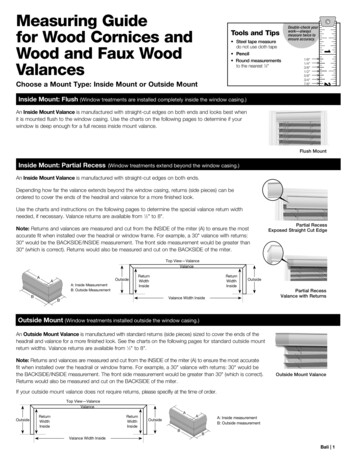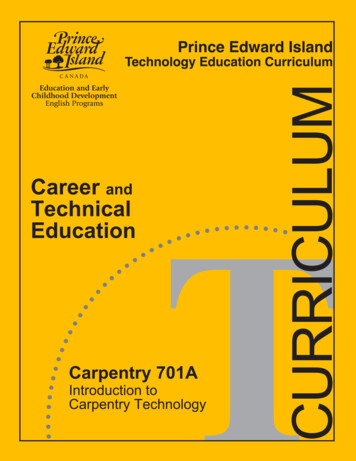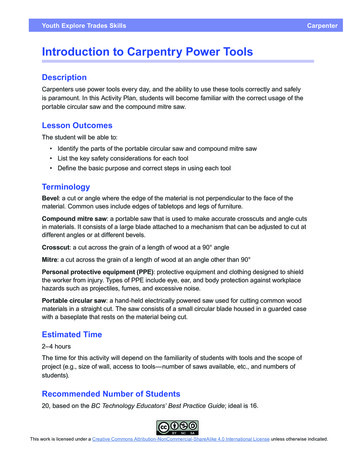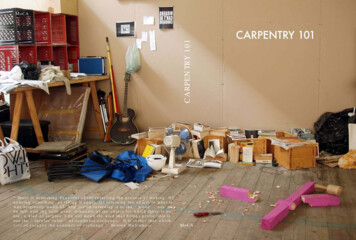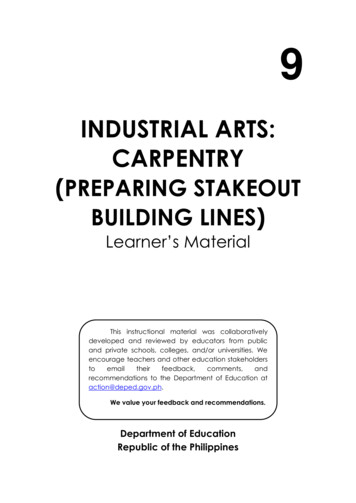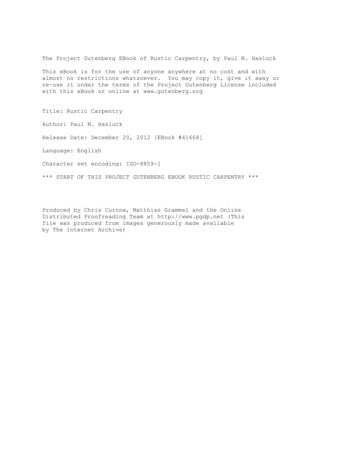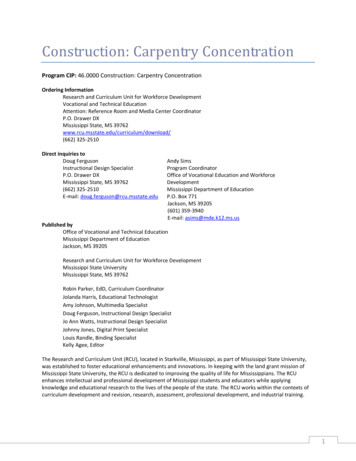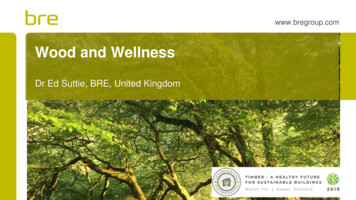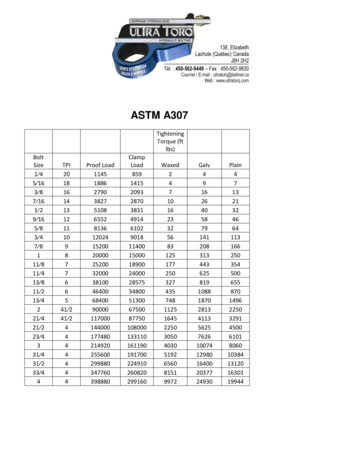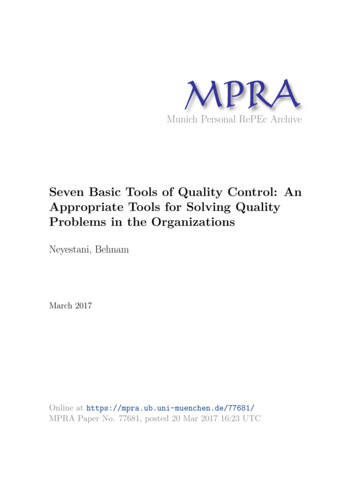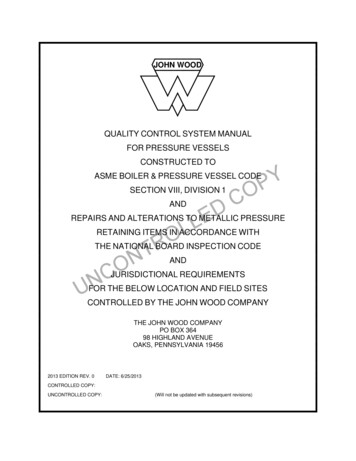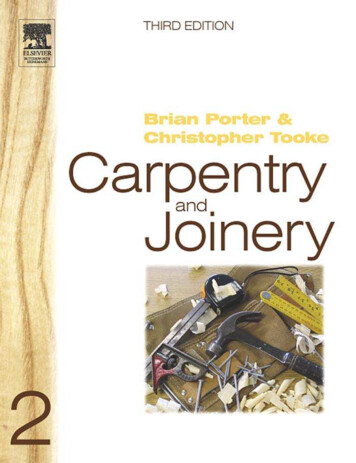
Transcription
Carpentry and JoineryVolume 2
This page intentionally left blank
Carpentry and JoineryVolume 2Third EditionBrian PorterLCG, FIOC, Cert EdFormer Lecturer at Leeds College of BuildingandChristopher TookeLCG, FIOC, Cert EdFormer Lecturer and Programme Manager atEaling, Hammersmith & West London College,Chief Examiner for the Institute of CarpentersAMSTERDAM BOSTON HEIDELBERG LONDON NEW YORK OXFORDPARIS SAN DIEGO SAN FRANCISCO SINGAPORE SYDNEY TOKYO
Elsevier Butterworth-HeinemannLinacre House, Jordan Hill, Oxford OX2 8DP30 Corporate Drive, Burlington, MA 01803First published by Arnold 1984Second edition by Arnold 1991Reprinted by Butterworth-Heinemann 2001, 2002 (twice), 2003Third edition 2005Copyright 2005, Brian Porter and Christopher Tooke. All rights reserved.The right of Brian Porter and Christopher Tooke to be identified as the authors of thiswork has been asserted in accordance with Copyright. Designs and Patents Act 1988No part of this publication may be reproduced in any material form (includingphotocopying or storing in any medium by electronic means and whetheror not transiently or incidentally to some other use of this publication)without the written permission of the copyright holder except in accordance with theprovisions of the Copyright, Designs and Patents Act 1988 or under the terms of a licenceissued by the Copyright Licensing Agency Ltd, 90 Tottenham Court Road, London,England W1T 4LP. Applications for the copyright holder’s written permissionto reproduce any part of this publication should be addressed to the publisher.Permissions may be sought directly from Elsevier’s Science and Technology RightsDepartment in Oxford, UK: phone: ( 44) (0) 1865 843830;fax: ( 44) (0) 1865 853333; e-mail; permissions@elsevier.co.uk.You may also complete your request on-line via the Elsevier homepage(http://www.elsevier.com), by selecting ‘Customer Support’ and then ‘ObtainingPermissions’British Library Cataloguing in Publication DataA catalogue record for this book is available from the British LibraryLibrary of Congress Cataloguing in Publication DataA catalogue record for this book is available from the Library of CongressISBN 0 7506 6504 1For information on all Elsevier Butterworth-Heinemann publications visitour web site at http://books.elsevier.comTypeset by Charon Tec Pvt. Ltd, Chennai, Indiawww.charontec.comPrinted and bound in Great Britain
ContentsForeword by W. R. RoseForeword by David R. WinsonPrefaceAcknowledgementsCHAPTER ONE SITE SETTING-OUT1.11.21.31.41.51.61.71.8Linear measurementStraight linesRight anglesAngles other than right anglesCircles, arcs, and segmentsDatumsLevellingVertical setting-outCHAPTER TWO2.12.22.32.42.5FENCES AND HOARDINGFencesHoardingSignboardsPostsWeathering and maintenanceCHAPTER THREEFORMWORK (TEMPORARY WORK)viiiixxxii11781418182133373741454547513.1 Design3.2 Pre-cast work (mould boxes)3.3 In situ formwork (shuttering)525456CHAPTER FOUR694.14.24.34.44.54.64.7TURNING PIECES AND ARCHED CENTRES UP TO 1-M SPANMethods of setting-out geometric arch shapesDetermining the length of radii by calculation to form an arcTurning piecesCentresCentre constructionErecting centresEasing and striking70737576767981
viContentsCHAPTER FIVE5.15.25.35.45.5GROUND FLOORS82Construction of floorsConcrete floors incorporating timberThermal insulationFlooring (decking)Skirting board8491919398CHAPTER SIX6.16.26.36.46.56.66.7SINGLE UPPER FLOORSFloor joistsTrimming openingsStruttingNotching joistsFlooringInsulationSafetyCHAPTER SEVEN7.17.27.37.47.57.67.77.87.9SINGLE TIMBER FLAT ROOFSRoof joistsAbutment to wallsEaves treatmentVerge treatmentRoof anchorageRoof deckingStages of constructionThermal insulationRoof coverageCHAPTER EIGHTROOFS OF EQUAL 1221231251278.1 Roof terminology8.2 Types of single-pitched roofs8.3 Roof geometry8.4 Double roof or purlin roof8.5 Steel roofing square8.6 Trussed roofs8.7 Trussed-rafter roofs8.8 Roof anchorage8.9 Roof openings8.10 Thermal insulation and ventilation8.11 Eaves details127129135137138143145152153154157CHAPTER NINE1619.19.29.39.4PARTITIONS (NON-LOAD BEARING)Timber stud partitionsProprietary partitions of panel constructionInsulationProtection from fire162172173179
ContentsCHAPTER dersTrestle scaffoldTubular scaffoldTiesAccess towersSystem scaffoldInspection of scaffoldingvii180181185187193193194197201
Forewordby W. R. Rose, author of Carpentry and Joinery:Bench and Site Skills and Carpentry and Joinery:Work ActivitiesThe craft of the Carpenter and Joiner has a long and honourable history; from the time timber was first worked with stone tools. Thegreat public and ecclesiastical buildings of the past and present are atestimony to the skill of those who chose to earn a living as workersof wood.This skill, as in any other craft, depends upon the manipulation of thematerial, the proficient and confident use of machines and tools, anunderstanding of the characteristics of the material being fashioned,and the knowledge of how and why timber and timber products areworked and used.Before the Great Fire of London in the 17th Century Carpentry andJoinery was based on custom and practice, but today with the speed ofdevelopment of new materials, tools and techniques National, Europeanand International legislation allows for the introduction of Regulationsand Specifications which proscribe our actions as woodworkers, inorder that we work in a safe manner, produce structures and productsthat are sound and fit for the purpose for which they are to be used, andconforming to prescribed requirements.If the manufacture and installation of doors and windows do not meetthe required standards and specifications warmed air is unnecessarilylost from the building, and additional carbon emissions are producedin replacing this heat loss.Messer’s Porter and Tooke in this revised 3rd edition of Brian PortersCarpentry and Joinery 2 have provided information for the studentand practicing Carpenters, details of the current legislation, the latesttimber products, tools, and the craft techniques essential for the goodpractice of woodworking skills
Forewordby David R. Winson, Registrar of theInstitute of CarpentersAnybody having an interest in Carpentry and Joinery, whether theyare undertaking an NVQ or SVQ, carrying out additional study toenhance the same by preparing for an Institute of Carpenters qualification, or even purely for reference, will find this book a valuableaddition to their toolkit.This book, the second in a series of three, provides the reader withstep-by-step practical advice and sufficient knowledge to reach competency in a number of areas associated with on-site works. Its textis concisely written and the accompanying illustrations are clearlydefined, helping the reader to quickly understand the subject matter.Throughout its pages the book gives clear guidance, particularly inregard to Health and Safety and other equally important regulations,to enable the reader to carry out a wide range of different work bothcompetently and safely.It has been a privilege to review this further revised and updatededition of a much renowned textbook used extensively by thoseengaged in teaching the craft of Carpentry and Joinery. This book,along with the other two books of the series, has been included in theInstitute of Carpenters’ recommended reading list for nearly twodecades and will continue to be so.It has been particularly so in the knowledge that the authors, bothmembers of the Institute, have more than seventy years’ membershipbetween them.I wish all readers every success in their chosen careers and I amconfident that this book will assist greatly in that success.
PrefaceThe Building Industry is constantly changing with the introductionof new ideas and innovations. Since the last edition of Carpentry &Joinery Book 2 we have witnessed numerous changes to the BuildingRegulations and a movement to bring British Standards in line withEurope. Further pieces of legislation have also had a marked effecton our trade and how we operate – particularly in regard to Health andSafety.Training needs for students have also seen major changes, with amuch greater emphasis towards work based on the job training –qualifications now available to the Carpenter & Joiner now include:QualificationLevel AvailableNVQ (NationalVocationalQualification)Wood Occupations:Levels 1, 2, & 3SVQ (ScottishVocationalQualification)Wood Occupations:Levels 1, 2, & 3ConstructionAwardWood Occupations: Foundation Intermediate Advanced冧CITB (ConstructionIndustry TrainingBoard) and C&G(City & Guilds)IOC Carpentryand JoineryCarpentry & Joinery: Foundation Intermediate Advanced Craft(MIOC) Fellow (FIOC)冧Institute of CarpentersMasterCertificateScheme CarpentryJoineryShopfittingAwarding BodyInstitute of CarpentersThe Worshipful Companyof CarpentersCity and GuildsThe Worshipful Companyof Joiners and CeilersWith this revised new edition, we have taken into account all thechanges we thought necessary in order to furnish the student or
Prefacexicraftsperson with updated information. This meets the requirementsnecessary for their endeavour to gain enough knowledge within theirchosen Wood Occupation to be successful in their examinations andchosen career.Because of the extensive cross-references and index in the bookyou should find navigating through it, and across the series quite asimple task.Furthermore, references to Building Regulations, British Standardsetc, are included at the end of each chapter.This book has been revised to compliment new editions of Carpentry &Joinery 1 and Carpentry & Joinery 3. As with all the books in theseries, you will find that due to its highly illustrative content, it isvery easy to follow. We believe that a textbook of this nature deserveswell-detailed pictures and annotated diagrams which speak louderthan words.The first edition of this book came into print over 20 years ago andhas proved itself time and time again as a valuable source of reference to students of all the wood trades across the world.Finally, we both feel and ardently believe that Brian’s final sentenceof the Preface in his first edition, is as important as ever . . . “Perhapsit could be said that the good craft worker is one who signs his or herwork with pride.”Brian Porter & Christopher TookeJanuary 2005
AcknowledgementsFor this new 3rd edition we are both indebted to the help and assistancegiven by the following people and organisations, who helped us produce this volume and supplied all the necessary information. Also fortheir kind permission to reproduce photographs or illustrations.Acrow plc: Fig. 3.20Mrs B Cook of Building Research Establishment (BRE): CrownCopy-right extract Fig. 8.25, excluding diagram (d), originally fromDefect Action Sheet DAS 83 (1986).Bosch Ltd (UK): Figs 1.1, 1.4, 1.5, 1.24, 1.25, 1.30, 1.44. Source:Bosch Power Tools, www.Bosch-pt.com.Stacey Davis of British Gypsum (UK): Figs. 9.15, 9.16Trevor Gibson of Gibson & Co Ltd: Fig. 8.13bNoel Hall: Fig. 2.12Health and Safety Executive (HSE)Karphos GmbH & Co. KG, Germany: Fig. 9.14Mowlem Northern Ltd: Figs 2.13, 3.13, 3.16, 3.18, 3.21National House Building Council (NHBC)Optical Measuring Equipment Cowley LtdRecord ToolsKatherine Hughes of RMD Kwikform Ltd: Fig.10.18, 10.20Peter Bond of SGB Scaffolding Ltd (UK) Ltd: Fig. 10.19Andrew Burns of Stanley Tools Ltd: Fig. 8.13a, 8.18, 8.19. Figs. 8.18and 8.19 re-drawn from Stanley QuickSquare Instruction Manual(1990).
AcknowledgementsxiiiTruss Rafter AssociationJeremy Vibert of TRADA: Fig. 8.20York Survey Supply Centre: Figs 1.33, 1.34 (photo)Amanda Wright of British Standards Institute (BSI), 389 ChiswickHigh Road, London W4 4Al, from whom copies of complete standards may be obtained:Table 3.1 (BS 8110-1: 1997), Table 10.4 (BS 5973: 1993), (BS EN60825: 1997), (BS 1282: 1999), (BS 4072: 1999), (BS 4261: 1999),(BS 5589: 1989), (BS 5268-5: 1989), (BS 5707: 1997), (BS 8110-1:1997), (BS 5975: 1996), (BS EN 312: 2003), (BS 8103: 1996), (BS476: 1997), (BS EN 39: 2001), (BS 1139: 1991, 1994), (BS 1129:1990), (BS 5973: 1993)Finally to Hilary Yvonne Porter for her continual help patience andsupport – to both of us, during the writing of this book.Brian Porter & Christopher Tooke
This page intentionally left blank
1Site setting-outSetting-out involves different processes; one or more of which willbe necessary before starting any constructional work. They includethe following: linear measurement,working to a straight line,setting out angles,setting out concentric curves,establishing a datum,levelling,vertical setting-out.The accuracy with which these are carried out will determine thefinal outcome of the work.1.1 LinearmeasurementMeasuring distances greater than 1 m generally means using aretractable tape measure.1.1.1 Measuring tapesAvailable in a variety of lengths, made of steel or fibreglass coatedwith polyvinyl chloride (PVC) (linen tapes are now obsolete becauseof their tendency to stretch, they have been superseded by PVCcoated fibreglass types). Tapes under 10 m in length have a built-inlockable automatic retractable rewind mechanism (see Volume 1,Section 5.1.3), longer tapes are rewound manually.Digital measuring tapes are available like the one shown in Fig. 1.1.Its liquid crystal display (LCD) panel is battery operated with automatic cut-off – measuring accuracies of 1 mm can be expected upto 5 m.In use, the accuracy of a measuring tape will depend on: the clarity of its graduations;whether it is held in the correct plane (Fig. 1.2);
2Site setting-outRewind buttonLCD – displaySDMBMOBOSCHⴙMⴙDECYLAISPDMeasuring unit(m/mm or ft/in) buttonONCancel button4‘Add’ casing length button123Retrieve total button (display)Memory/add button‘On’ buttonFig. 1.1 Bosch digitalmeasuring tapeMetric & imperialtape measureKeep tape taut and in the correct measuring planeMea
Carpentry and Joinery 2have provided information for the student and practicing Carpenters, details of the current legislation, the latest timber products, tools, and the craft techniques essential for the good practice of woodworking skills. Foreword by David R. Winson, Registrar of the Institute of Carpenters Anybody having an interest in Carpentry and Joinery, whether they are undertaking .
